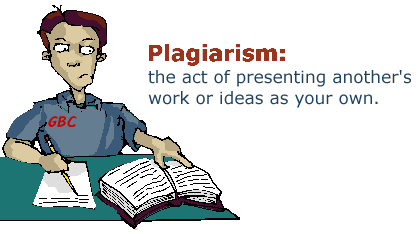
|
|
 |
Avoiding Plagiarism |
Common Knowledge:
Common knowledge includes facts or ideas that can be found in numerous places and are likely to be known by many people.
Example:
Toronto has four major daily newspapers: The Toronto Star, The Globe & Mail, The National Post, and the Toronto Sun.This is generally known information and does not need to be documented.
However, you need to document facts that are not generally known and ideas that interpret facts.
Below is an example of a fact that is not common knowledge
A recent poll shows almost a third of Americans believe Canada is just another state in the US.
This statement needs documentation. The following points need to be made: who gave the survey (Ipsos-Reid), where it was reported (Globe & Mail) when it appeared (May 7, 2002), and what page it was reported on (Page 1). The documentation would consist of an in-text citation and a bibliographic reference in the Works Cited Section of your essay.
Quotation:
Quotation is using someone's words. When an exact quote of a few lines is used, the passage should be enclosed by quotation marks and the source should be documented according to standard documentation style.
The following is an example using the Modern Language Association's style (MLA)
According to an article in the Globe & Mail on May 7, 2002 an Ipsos-Reid poll showed that, "Almost a third of Americans consider Canada just another state, many mistakenly think Japan and China are their biggest trading partners and most say Britain is their country's best ally."(1)
For a longer quotation, do not enclose the passage in quotation marks; instead, indent the entire passage and use proper documentation.
Example:
According to an article in the Globe & Mail on May 7, 2002 an Ipsos-Reid poll showed that,
Almost a third of Americans consider Canada just another state, many mistakenly think Japan and China are their biggest trading partners and most say Britain is their country's best ally, a new poll shows.
But like hopelessly infatuated teenagers, Canadians remain stubbornly loyal to the Americans who ignore them: 60 per cent of the Canadians surveyed described the United States as Canada's closest friend and ally, while only 18 per cent of US respondents said the same. (1)Paraphrase:
Paraphrasing is using someone else's ideas by putting them in your own words. This is a skill you will learn to master when incorporating sources into your writing. Although you use your own words to paraphrase, you must still acknowledge the source of the information
Example: Would you believe that one third of Americans believe that Canada is the 51st state? Well, a recent poll conducted by Ipsos-Reid found just that! (Globe & Mail, 1)
Standard Documentation Formats:
Different disciplines use their own systems to give information about sources. The two most common are MLA (Modern Language Association) and APA (American Psychological Association). Most of your courses will require MLA but some teachers may prefer APA.
Two excellent handbooks that include detailed information on documentation are:
Quick Access: Reference for Writers, Canadian Edition by Lynn Quitman Troyka, published by Prentice Hall (2000)
A Canadian Writer's Guide by Jack Finnogason and Al Valleau, published by Nelson Thomson Learning (2002)
Two excellent sources of online information are:
OWL Online Writing Lab at Purdue University --MLA Documentation, APA Documentation
Try a citation generator:
EasyBib- Free Bibliography Generator
If you are using your own computer, it is recommended that you link to those sites and bookmark them for future reference!
For more information about plagiarism, go online to the OWL Online Writing Lab: Avoiding Plagiarism or this guide http://wiht.link/studentplagiarismguide
For the Absolute BEST Site on the Web that discusses all issues relating to using the web, documenting sources and information literacy go to TILT-Texas Information Literacy Tutorial. Their site is an interactive tutorial that even personalizes the experience. It's an absolute must see and do site!! (Can you tell?.....I love their site!)
...Continue on to find out how much you know about the Student Association..